Oak, Garry (White) (Quercus garryana) Native
Oak, Garry (White) (Quercus garryana)
Parts used: acorns, bark
Medicinal and other uses: The acorns were leached of tannins and eaten, often ground into flour. The bark was one of the ingredients in the Saanich ‘4 barks’ medicine used against.
Cautions: None stated tuberculosis and other ailments (Pojar 50).
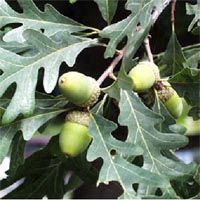
Pacific Northwest Medicinal Plant Guide (Check out all plants growing in Tryon Farm's medicinal garden!)
- Login to post comments



Mullein (Verbascum thapsus) Non-Native
Mullein (Verbascum thapsus)
Parts used: flowers, leaves
Medicinal uses: Dried flower petals and leaves treat coughs, influenza, bronchitis. Used as a diaphoretic and diuretic, to treat wounds and other skin disorders
Cautions: None stated.
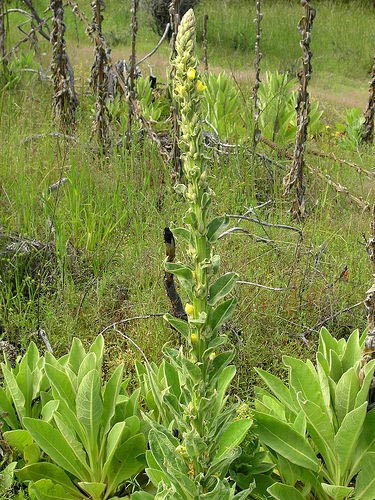
Pacific Northwest Medicinal Plant Guide (Check out all plants growing in Tryon Farm's medicinal garden!)
- Login to post comments



Mugwort (Artemisia vulgaris) Non-Native
Mugwort (Artemisia vulgaris)
Parts used: leaves, root
Medicinal uses: A digestive and tonic herb, it has a wide variety of traditional uses. Milder in action than most Artemisia species, it can be taken over the long term at a low dose to improve appetite, digestive function, and absorption of nutrients. In addition to encouraging the elimination of worms, mugwort increases bile flow and mildly induces the onset of menstruation. Mugwort is also an antiseptic and has been used in the treatment of malaria (Chevallier 173).
Additional uses: Mugwort leaves have a sage-like smell and are used to repel moths. The plant dries well and can be used in less formal herbal arrangements (Kowalchik 392).
Cautions: Do not take during pregnancy (Chevallier 173).
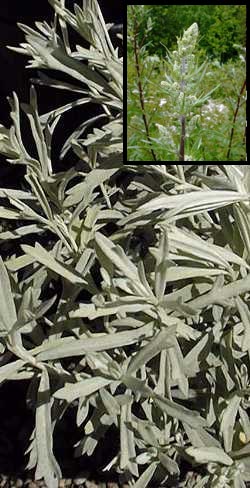
Pacific Northwest Medicinal Plant Guide (Check out all plants growing in Tryon Farm's medicinal garden!)
- Login to post comments



Motherwort (Leonarus cardiaca) Non-Native
Motherwort (Leonarus cardiaca)
Parts used: aerial portions
Medicinal uses: To treat nervous heart conditions. A gentle sedative and antispasmodic it encourages relaxation rather than drowsiness. Also used to calm anxiety during childbirth and used to stimulate uterine contractions.
Cautions: Do not take during pregnancy. It should also be avoided if there is heavy menstrual bleeding (Chevallier 226).
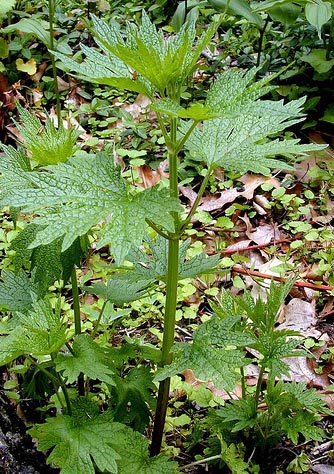
Pacific Northwest Medicinal Plant Guide (Check out all plants growing in Tryon Farm's medicinal garden!)
- Login to post comments



Mint (spearmint (Mentha spicata) and peppermint (Mentha piperita.)) Non-Native
Mint (spearmint (Mentha spicata) and peppermint (Mentha piperita.))
Parts used: aerial portions
Medicinal uses: To treat digestive disorders, to mask unpleasant taste of other herbs, irritable bowel syndrome, ailments of the gall bladder and bile duct, and catarrhs of the respiratory tract. Oil is antimicrobial, antiviral, and mildly anesthetic. Can be used topically to relieve pain, including headache and mucosal inflammation of the mouth (Chevallier 116).
Additional uses: Infused mint water can be used to tone and refresh the skin, especially in warm climates, be they humid or dry. It can be made by steeping 1 cup of spearmint or peppermint leaves in 1 quart of cool water, strain and chill. Use as needed. As a companion plant it is said to repel a variety if garden pests (Kowalchik 386).
Cautions: Do not give peppermint to children under 5 (Chevallier 116).
- Login to post comments



Marshmallow (Althaea officinalis) Non-Native
Marshmallow (Althaea officinalis)
Parts used: root, leaves, flowers
Medicinal uses: Root infusions and extracts used to sooth coughs, peptic ulcers, and inflammation of the mucosa of mouth, throat, and stomach. Leaf infusions used specifically for dry cough associated with irritation and inflammation of the respiratory tract. Externally applied to burns, sores, and ulcers (Chevallier 165).
Additional uses: The root was original source for the confection bearing this name. The young leaves and tops can be used in salads (Kowalchik 379).
Cautions: None known (Chevallier 165).

Pacific Northwest Medicinal Plant Guide (Check out all plants growing in Tryon Farm's medicinal garden!)
- Login to post comments



Lovage (Levisticum officinale) Non-Native
Lovage (Levisticum officinale)
Parts used: leaves, root, rhizome, seeds
Medicinal uses: Dried rhizomes and roots used as diuretic to treat edema, inflammations of the lower urinary tract, and to prevent kidney gravel. A warming and tonic herb improves poor circulation. Traditionally taken to improve digestion and as expectorant and emmenagogue. Also used as a spice and in liqueurs (Chevallier 227).
Additional uses: The leaves, stems and seeds all taste similar to celery. The leaves and stems can be used fresh or dried any way that celery is used (Kowalchik 369).
Cautions: Do not take during pregnancy, or if you suffer from kidney disease (Chevallier 227).

Pacific Northwest Medicinal Plant Guide (Check out all plants growing in Tryon Farm's medicinal garden!)
- Login to post comments



Lemon balm (Melissa officinalis) Non-Native
Lemon balm (Melissa officinalis)
Parts used: aerial portions
Medicinal uses: As a calming and soothing herb to treat minor sleeplessness and nervous stomach disorders. Also stimulates appetite and demonstrates activity against bacteria, fungi, and viruses, and is an ingredient in ointments and creams for topical use (Chevallier 115).
Additional uses: Steamy lemon balm facials are recommended for persons with acne. It also has reputed insect repellant properties. Consider tossing a handful or two of the leaves into the fire to prevent being bugged (Kowalchik 357).
Cautions: Do not take essential oil internally (Chevallier 115).
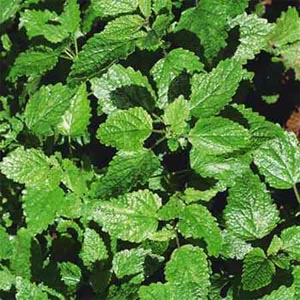
Pacific Northwest Medicinal Plant Guide (Check out all plants growing in Tryon Farm's medicinal garden!)
- Login to post comments



Lavender (Lavandula spp.) Non-Native
Lavender (Lavandula spp.)
Parts used: flowers (also edible)
Medicinal uses: Well known for its soothing and calming effect. It is commonly blended with other sedative herbs to relieve sleeplessness, irritability, headaches, and migraine. It also helps to alleviate depression. This plant soothes indigestions and colic and relieves gas and bloating. Its relaxing effect makes it helpful for some types of asthma especially where excessive nervousness is a feature. The essential oil is an exceptional first aid remedy. It is strongly antiseptic, helping to heal burns, wounds, and sores. It can be rubbed on insect stings and can be used to treat scabies and head lice. It relieves pain and inflammation. A few drops of the essential oil can be rubbed into the temples to relieve headache and to encourage sleep (Chevallier 110).
Additional uses: It’s exceptional fragrance and ease of drying make this plant an exceptional addition to dried flower arrangements and to potpourris. Vinegar steeped with lavender is reported to be very useful for oily skin (Kowalchik 351).
Cautions: Do not take essential oil internally (Chevallier 110).

Pacific Northwest Medicinal Plant Guide (Check out all plants growing in Tryon Farm's medicinal garden!)
- Login to post comments



Kinnikinnick (Uva Ursi) (Arctostaphylos uva-ursi) Native
Kinnikinnick (Uva Ursi) (Arctostaphylos uva-ursi)
Parts used: leaves, berries
Medicinal uses: One of the best natural urinary antiseptics; used in cases of acute and chronic cystitis and urethritis; it is not a suitable remedy if there is a simultaneous kidney infection.
Cautions: Do not take during pregnancy or with kidney disease. Unsuitable for children under 12. it is generally advisable to take uva-ursi for no more than 7-10 days at a time (Chevallier 170).
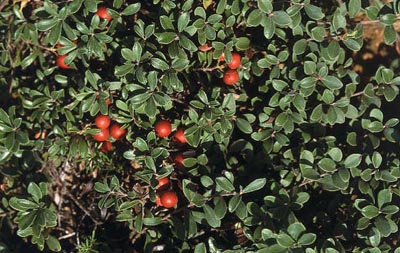
Pacific Northwest Medicinal Plant Guide (Check out all plants growing in Tryon Farm's medicinal garden!)
- Login to post comments



Feedback and participation welcome! Please send bug reports to web@tryonfarm.org







